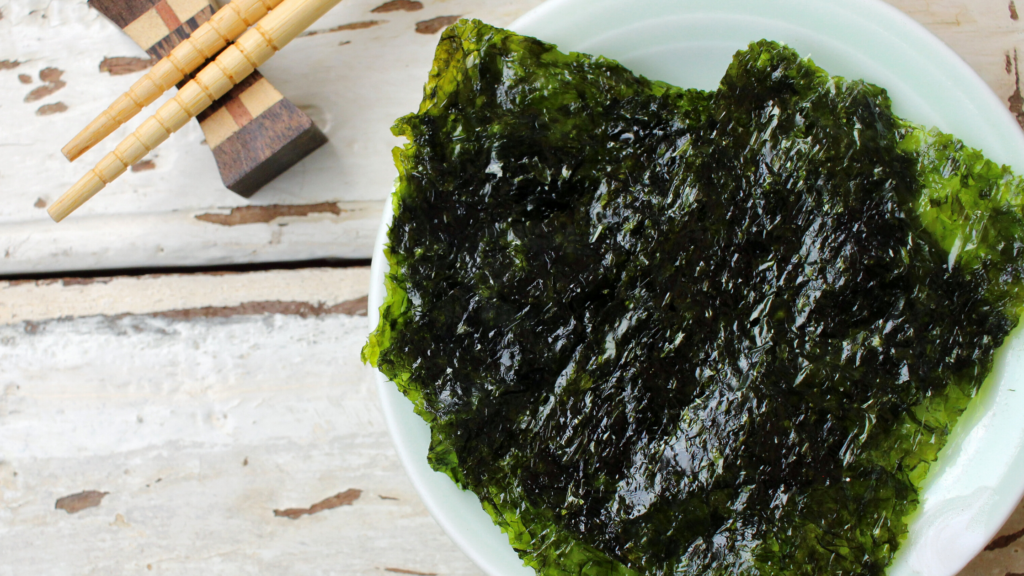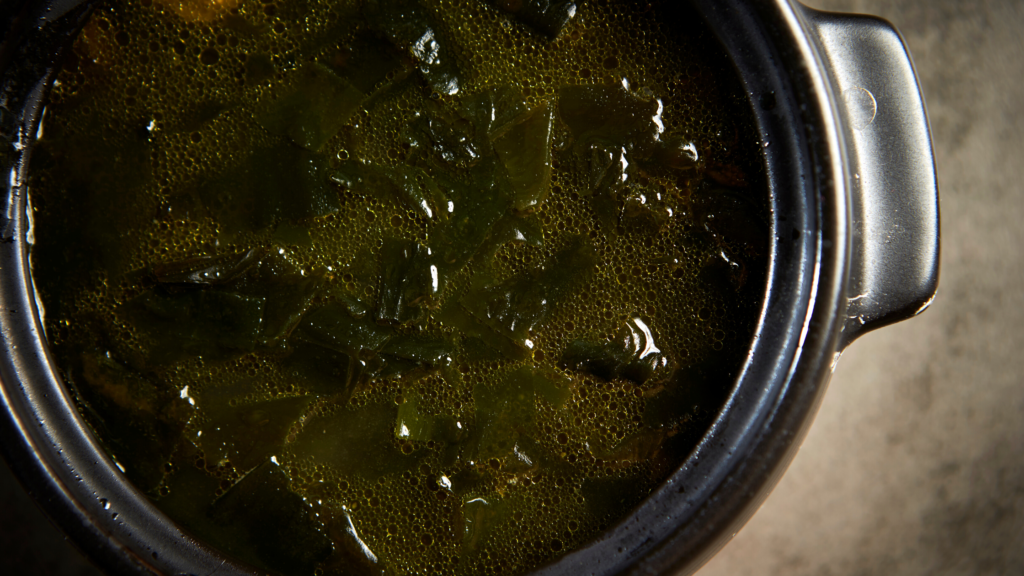Although seaweed on the beach might not look and smell the most appetizing, in South Korea seaweed is transformed into a delicious ingredient that is used in many different dishes, or eaten as a snack on its own. There are many different kinds of seaweed, and countless delicious seaweed dishes, soups, garnishes, and savory snacks. Seaweed really is an indispensable ingredient in Korean cuisine, so today let’s have a look at the most commonly enjoyed types of seaweed.

Contents
What Is Korean Seaweed
Colloquially, Korean seaweed is called Gim (also spelled Kim, 김 in Korean). Gim refers to all kinds of seaweeds that are dried and used in Korean cooking. Kimbap, for example, are rolls of rice wrapped in dried, salted sheets of seaweed. Kimbap (김밥) literally means seaweed-rice! There are also other kinds of seaweed eaten in Korea, namely miyeok and dasima.
Seaweed has a lot of nutritional value and is thus often added to dishes. It contains protein, thiamine, riboflavin, and vitamins A, B6, and B12, making it very nutritious. It also has a high content of mineral salts, like iodine and iron, and essential amino acids.
Types of Korean Seaweed
Let’s discuss the three types of seaweed – gim, miyeok, and dasima – a little more and explain how they are used.
1. Gim
To get a little scientific, gim refers to the species of seaweed in the genera Pyropia and Porphyra. There are many different kinds of seaweed out in the ocean, and many of them can be turned into edible gim. These species of seaweed are mostly red algae, which makes the color of gim dark purple or dark brown. In English, gim is often referred to as laver and many people also know it by its Japanese name: nori.
Gim is usually dried and then roasted, giving it a very savory flavor. Often, roasted gim is simply cut up into little rectangles and served as a side dish during a meal. You can use the gim to wrap up your rice and even meat, creating your own little kimbap.
If the roasted gim is seasoned with some salt, sesame oil, and even sugar, it is called gimjaban (김자반). Gimjaban is used as a topping on dishes such as bibimbap (rice mixed with vegetables) and noodle dishes. Gim can also be made into different snacks, like gimbugak (김부각) and matgim (맛김). More about that later…
There are different kinds of gim too. Dol Gim (돌김) literally means rock seaweed, and, as the name suggests, is grown on a rock. It has a naturally thick and coarse texture, which makes it perfect to just eat as is, or to wrap around rice.
Jaerae Gim (재래김) is one of the most commonly consumed types of gim. It is finer and softer in taste and texture than Dol Gim and is usually wrapped around rice.
Parae Gim (파래김) is a green laver. It has a very herby, fresh flavor. Because of its special flavor, it is usually mixed with other types of brown lavers, otherwise the herbal taste is too strong for some people.
Finally, Gimbap Gim (김밥김) is made from the species Porphyra Tenera, which has long leaves. This makes it perfect to make large sheets of gim for making kimbap.
2. Miyeok
Miyeok (미역) is a species of kelp that is not roasted by instead enjoyed in its wet, slightly slimy state. You might know it as wakame, from Japanese restaurants. Miyeok is seen as extremely healthy. In Korean traditional medicine, it has been used for blood purification, intestinal strength, skin, hair, reproductive organs, and menstrual regularity. Because of its high iodine and calcium content, miyeok is also consumed by women after giving birth.
Miyeok is usually consumed as a soup: miyeokguk (미역국). Miyeokguk is usually flavored with a beef or seafood broth and it is always eaten on birthdays, as a reminder of the first food their mother has eaten and passed on to their newborns through nursing. Eating miyeokguk is even more common than eating cake on birthdays! Miyeok is also sometimes used for side dishes.

3. Dasima
Lastly, we have a seaweed that is never the main star of a dish, but is completely unmissable. Dasima (or dashima, 다시마) is a kelp that is used to flavor soups and broths. A simple sheet of dried dasima and some anchovies is usually enough to create a flavorful broth. After cooking, dasima turns into a leathery sheet, that can be eaten as well. Sometimes it is fried to make a savory side dish.
Best Korean Seaweed
With such a wide variety of seaweed, it is almost impossible to say which Korean seaweed is the best. But, many people do agree there is a winner. Gamtae Gim is a special kind of gim that is grown under controlled conditions in the clearest waters off the west coast of South Korea. It is a type of brown algae that almost looks grass-like when dried. It is usually grown, collected by hand, carefully washed, and dried in the sun. It is then roasted and flavored with sesame oil, although it can also be eaten simply dried.
It has a unique texture, almost like a paper-thin woven grass mat, and a unique taste. Compared to regular gim, it is a lot more fresh and herbal. Gamtae Gim is used by Michelin-star restaurants in the United States and Belgium. Gamtae powder is also widely used to flavor dishes. You can buy high-quality Gamtae Gim from So Good K.
Best Korean Seaweed Brands
There are countless different brands selling Gim. You can go to any supermarket to buy laver and most popular food brands sell them, such as Bibigo and Pulmuone. Here an overview of some of the most popular brands.
1. Daechungim (대천김)
Daechungim is one of the oldest and most popular laver brands in Korea, with over 40 years of experience. They mainly focus on producing gim, so you can be assured that it is of high quality. Their Jaerae Gim – traditional laver – is very popular.
2. Hyundaekim (현대수산맛김)
Hyundaekim is known for its exquisite flavor. They use a special roasting technique, roasting the gim long, which gives it a special, almost nutty flavor.
3. Dongwon F&B (동원F&B)
Dongwon F&B is a regular Korean food brand that makes all kinds of foods, such as gim! They produce roasted gim in many different flavors, such as sesame oil, perilla oil, and olive oil.
4. Kwangcheongim (광천김)
Kwangcheongim was founded in 1970 and has since exclusively focused on creating the most delicious gim. They have the largest, and most advanced, gim production facility and produce all sorts of gim: roasted, kimbapgim, seaweed snacks, and more.
5. Seongyeong Gim (지도표 성경김)
A high quality seaweed harvested from November till January. Flavoured oil was used to create a delicious gim laver.
Best Korean Seaweed Snack
Besides using seaweed in cooking, it can also be had as a snack. As laver is nice and savory, it is a great drinking snack.
1. Gimbugak (김부각)
Gimbugak is made of several sheets of gim glued together by rice paste. The bundle is battered and deep-fried or toasted, so it puffs up and becomes crunchy. It is sometimes served as a side dish in restaurants, or as a drinking snack.
2. Matgim (맛김)
Matgim literally means flavored laver, and that is exactly what it is. The gim is dried and roasted, after which a flavor is added. This flavor can be wasabi, teriyaki sauce, but also buldak sauce (an extremely spicy sauce that is often used when eating ramen). They can be eaten simply as a snack, or wrapped around rice.
3. Gimjaban (김자반)
Gimjaban is a finely shredded roasted laver, that has been seasoned with salt, sesame oil, sugar, and sesame seeds. It is great as a side dish and can also be added to dishes as a garnish.
4. Dasimabugak (다시마부각) and Fried Dasima (다시마튀김)
Dasima can also be fried to make a delicious snack. Like Gimbugak, it can be coated with rice paste and deep-fried to make Dasimabugak. It can also be deep-fried and flavored with salt and sugar.
Frequently Asked Questions
Many people say that Gamtae Gim is the best Korean seaweed. It has a unique texture, almost like a paper-thin woven grass mat, and a herbal and fresh flavor. It is even used by Michelin-star restaurants!
Seaweed and laver themselves are very healthy, they contain a lot of nutrients such as protein, thiamine, riboflavin, and vitamins A, B6, and B12, and some minerals. So adding dried and roasted laver to your dish is a great idea! However, be careful with seaweed snacks, as they are often deep-fried and coated in oil. If you eat them in moderation, they are still healthy, but be aware of the fat content!
